Kuressaare Castle & Tallinn, Estonia Day 6-8
DAY 6 – Island of Saaremaa in Estonia
What a lovely day this was. Probably the best preserved medieval castle in the Baltics is Kuressaare Castle. It was built in the 14th century for a Bishop that controlled the area. It is also known as the Episcopal Castle or the Bishopric Castle. It is now a history museum that Mike and I spent a good 3 hours visiting. In this part of the world you spend a lot of time learning about the history of the places you are visiting. The occupations and turnovers and repercussions are real life history to these people. Just in the last 100 years Estonia has been German, independent, Russian, German, Russian, independent and if you go back earlier you also have the Swedes and the Danes in possession. After visiting the museum we drove around the island. During the Russian occupation this island was not accessible to Estonians other than a few local residents. Russia had radar installations, guns etc. all along the coast. This island is the main separation of the Gulf of Riga from the Baltic Sea.
Lots of the homes in the little villages had their own small barns. I found this strange as they were almost in a “subdivision” and there were no obvious small plots of land attached to each home. During the Russian days they had very large collective farms. Everywhere you drive you see large buildings that are all deserted and falling down. We think these were the barns and working areas for the collective farms. Since then all these little barns almost in town seem to have popped up. A large meteor had fallen through the atmosphere about four thousand years ago and broken up into pieces. There were 9 significant meteorite craters in this one area. The largest and most well-known was the Kaali crater with Lake Kaali at the bottom. Mike and I hiked all the way around the edge of the crater. This would sound a lot more impressive if I didn’t tell you that the entire crater was only 122 metres in width. 🙂
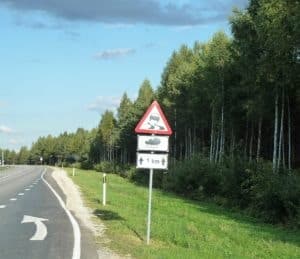 We didn’t have the time to travel around the areas of the country where the remnants of the Russian installations on the coast were as we ended up leaving that evening. The ferry is great. Again we drove up to the terminal and this time we had to wait all of 5 minutes before we drove onto the ferry. It is a 30 minute crossing. I sat outside. The wind was unbelievably warm for this far north. Actually the temperature has been great for walking around in. Light sweater and no coats nearly all the time. If you discount Monday with all its rain the weather has been super also. Have a look at this sign on the side of the road. I am not sure if you can see it properly but it appears to be warning you that it will be raining 1km ahead. Interesting that they might know that when they built the sign!
We didn’t have the time to travel around the areas of the country where the remnants of the Russian installations on the coast were as we ended up leaving that evening. The ferry is great. Again we drove up to the terminal and this time we had to wait all of 5 minutes before we drove onto the ferry. It is a 30 minute crossing. I sat outside. The wind was unbelievably warm for this far north. Actually the temperature has been great for walking around in. Light sweater and no coats nearly all the time. If you discount Monday with all its rain the weather has been super also. Have a look at this sign on the side of the road. I am not sure if you can see it properly but it appears to be warning you that it will be raining 1km ahead. Interesting that they might know that when they built the sign!
We drove straight into Tallinn which is the capital of Estonia and by far its major city. When the Olympics were held in 1980 in Moscow the yachting events were held in Tallinn. We spent the first night at the Marina built for the Olympic yachting events. There was a casino on the premises attached to a hotel. We went into the casino to get something to eat. We were officially told that this was a casino NOT a restaurant and that there was no food. They had a registration desk at the front. We asked if we could go in and look around. Again we were told NO, didn’t we know that this was a CASINO! Las Vegas it wasn’t. You could see the skyline of Old Tallinn across the harbour. The views and the sunset were spectacular. We eventually ate high up in the hotel overlooking the water and the bay.
Day 7 – Old Tallinn
Another spectacular day. Not a cloud in the sky. I walked around in a long sleeved shirt and no jacket the entire day. Old Tallinn is great to see and walk in. We spent quite a while in one of their museums. There are about 6 or more museums on the “Must See” list but 3 hours was probably enough. The museum was really well laid out. It had English translations for everything. On the floor that covered the latest Soviet occupation era there was an old man there, probably a volunteer, who spent ages explaining everything to us and one other couple. The other couple was from……….TORONTO. What were the chances! It was fascinating listening to this gentleman cover the war and what happened. He kept quizzing us to see what we knew. One interesting fact he gave us was about a much earlier time in history. If I remember correctly it was about 1700. Peter the Great had decided that he wanted to build a new modern ship building city in Narva which is a town north of here and borders Russia. The Swedes decided that they didn’t want this happening and the two sides basically fought it out near Narva. The Swedes won and Czar Peter the Great then had to find a new location with a good harbour and so St. Petersburg was born. I am hoping to get to Narva but it is slightly out of the way and as I said I am already concerned about our time.
Wandering around Old Tallinn is just wonderful. I really enjoy the opportunity to spend the day with Mike just walking around these places. The streets are mainly cobblestones. There aren’t as many squares here as in old Riga but the main ones are very large. The shops are quaint and what is really unique is that you go from seeing a little shop to seeing part of the old city wall between the buildings, a little further on the wall might be part of a restaurant. I understand that the Baltic states all share a love of music. What I haven’t seen here are the street musicians or music groups that we saw in Riga. This may be a difference between the towns or it just may be that we were in Riga for the last weekend of the summer and we are in Tallinn during the middle of a school/business week.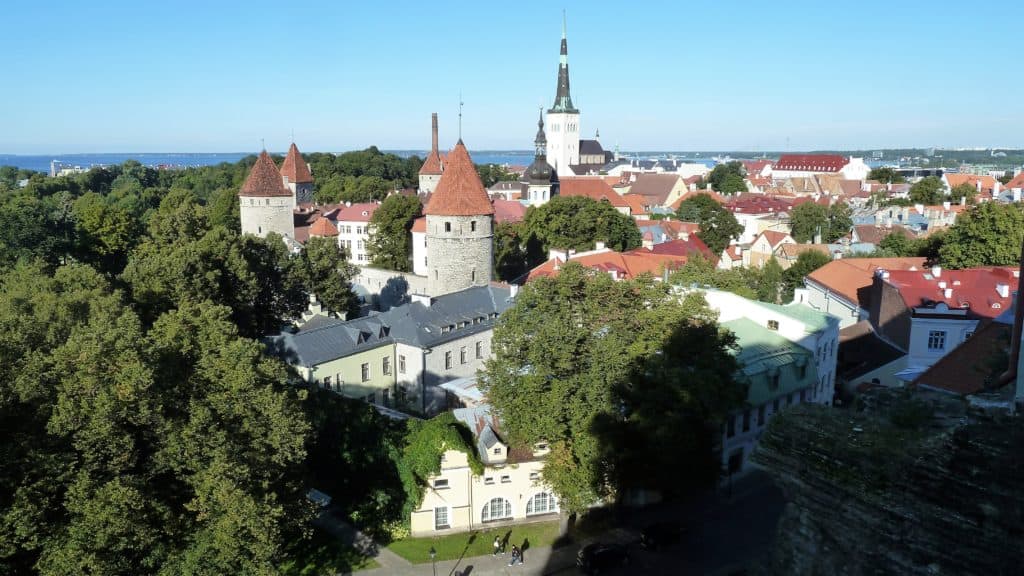
What we call unions today were called Guilds back in the old days. You had the potter’s guild and the baker’s guild etc. These guilds had tremendous amounts of power. They literally ran the Town Council for example. The Guilds set their own rules for who could be “masters”, everyone else stayed serfs or apprentices. For example the Bakers Guild decided that to be a master baker you had to be of German ethnicity. This prevented any local individual from attaining that status. I saw a sign in the museum from the 17th century. I am repeating it here. I thought it was fascinating because it could so easily have been written about today.
“Potters: The potters’ trade applied to the Town Council several times in the 17th century about the Dutch and Lybeck traders bringing in a great amount of stove tiles and cheap pottery made of red clay that were also locally produced. They said they had nothing against the import of white, blue and gilded mugs, dishes and plates that the local masters could not produce due to the lack of suitable raw material but they strongly objected to items of red clay. In 1686 the Town Council indeed prohibited the import of red clay items.
Another appeal concerned the time of selling the imported items. Local potters wanted the time limited to a fortnight and whatever remained unsold they wanted to be taken back on the ship, so the foreigners could not give the unsold items cheaply to local sellers who then would be dealing with them a whole year afterwards. In 1693 the Town Council prohibited the local sellers to store foreign-made pottery on their premises.”
When you walk outside the old city and onto the main thoroughfares the noise seems so loud compared to the old part of the city where there are no cars. I forgot to tell you about our introduction to Old Tallinn. We decided to have a look around the town before we camped for our first night. Well somehow we ended up in the centre of this old town with tiny cobblestone streets in our RV. This is a pedestrian only area. It would have been a very interesting view if we weren’t both petrified that we were going to either get completely stuck in one of these little streets or we were going to be stopped by the police or something. The big concern was getting in somewhere that we couldn’t easily get out of. We were driving around the little tourist stands and the cafes that went out into the street. It was very uncomfortable. Did we ever breathe a sigh of relief when we finally saw some parked cars at the side of the road. This meant that there was actually some traffic in this area and we must be near the exit of the old town. Very uncomfortable.
Tomorrow we are having lunch with my Estonian business partner. I am really looking forward to it. I am actually hoping that he is a little older than Gabriel and his sister. I would like to talk with someone who lived through the occupation and independence as a business man. Whatever age, I am sure it will be an interesting lunch. There are a few things I would like to see in Tallinn outside of the old city before we leave the area. Unless something unexpected comes up at lunch I expect to start driving away from here late tomorrow afternoon. I will finish and send this note when we leave Tallin. Sorry if it is getting too long.
Day 8 Tallin towards Narva Friday Sept 6
There are lots of cruise ships still coming into Tallinn daily. That may be how the other Canadian couple from the museum arrived.
The people that we met with turned out to be younger, not older than our last contacts. It was their parents and grandparents who lived through the occupation and independence. The office staff consisted of four people all in their 20s and early 30s including the GM. I guess if a country has only had a free market for 20 years there is no “old boys” network and you can get ahead quickly. All four stopped work to sit down and talk with us and then take us to lunch. They tried to convince us to spend our time in Estonia and bypass the other countries. This was partially tongue in cheek but they were very nationalistic and proud of their country. They all got together to make us a map and route that we should take, specifically going through their largest national park alongside the ocean called Lahemaa.
They told us that males in Estonia have to do one year of military service between the ages of 18 and 27.
I tried to find out if there were problems between the Russians who still lived in Estonia and the Estonians. I gather that there are some tensions. They eventually said that the main problem was with Russians who wouldn’t learn to speak Estonian. I think that was true as far as it went but that the problems are probably even deeper than that. We talked a little bit about their social programs. They said that there is very little immigration into Estonia. Partly because of the climate and partly because if someone did want to immigrate to the north then Sweden had far better social programs for new people coming into the country so why go to Estonia. Apparently if you live in the city health care in Estonia is good and nationalized. The problem is for the people who live in the small towns and villages. Many don’t have cars and can’t get to the city for treatment. The way that they talked it was normal not to have cars in rural areas which surprised us.
When we first arrived at the office Mike happened to mention that we hadn’t been able to find the parking meter to pay for our parking. They instantly wanted our license plate number. One gentleman got on his cell phone and paid for our parking through a smart phone app. Every parking lot we have seen have wanted you to do this but most also had “old-fashioned” parking meters that you put money into. They each had a single government card somewhat like our social security card. This number was used for everything – parking, taxes, health, business filings, any time that you interacted with government programs. In Canada it is a big privacy deal that you keep OHIP information separate from taxes separate from child support payments etc. That isn’t a concern at all in Estonia – they like the efficiency.
They told us this “funny”story about Gabriel visiting Tallinn with his girlfriend and driving her right through the Old City which everyone knows you can’t do. At this point I signaled Mike not to mention that we had also done this but in a large RV and had gone right through their pedestrian town square!
We left the four of them immediately after lunch to start our drive towards Narva, the city right across a small river from Russia. We took the route suggested, which was basically what we had planned anyway just with a few additional stops. We visited various small towns on the way. We stopped at a couple of lovely manor homes and actually toured one of them. They were built during the German occupation. One of them had 52 hectares and many, many buildings. We stopped at one lovely campground just for coffee and a walk to the ocean. Coffee was awful, area was great. This part of Estonia has a lot of what they call “erratic” boulders. They are from the ice age and vary in size considerably from quite small to extremely large.
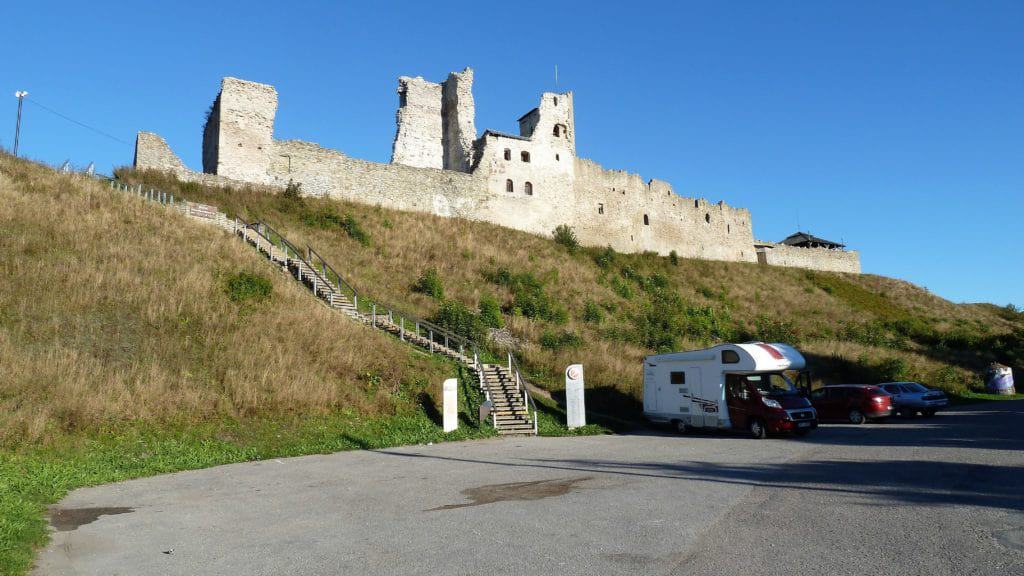
We drove around a town call Sillamae. After the war this town was completely off limits to anyone other than Russians. Its name was removed from maps and it was like it didn’t exist. The Russians had found out that they could extract small amounts of uranium from the local oil shale. An apparently infamous uranium processing and nuclear chemicals factory was quickly built by 5000 Russian political prisoners sent here. The lovely town centre was built by 3800 Baltic prisoners of war. Supposedly though, life was better for those who lived here than in other parts of Estonia. The town was planned by architects from St. Petersburg. It included some grand buildings, parks and many square apartment building complexes. The EU has spent a lot of money ensuring that the nuclear waste is stable and not leaking into the Baltic Sea. Today a lot of the buildings are still abandoned. The entire town’s population is only about 16,000. Some of the buildings have been refurbished and it is quite surprising the difference that makes. We saw one apartment block where there were some abandoned and some refurbished buildings. It was hard to tell that they had all looked the same at one point.
The whole area had a bit of a funny feel to it. It was getting late when we left and we turned into a campground not too far away. We went down a very long private road/driveway to a deserted campground. It felt very spooky and actually a little unsafe so I voted for us leaving there, even if it was getting late, and finding somewhere else to stay for the night. We ended up spending the night at a very nice spa hotel with a large separate indoor swimming pool. We were getting into Russian territory and this was the first time we had run into someone we needed to converse with who spoke no English at all. She did speak German but that didn’t help any. It still worked out fine. If we had more time we could actually appreciate and take advantage of some of these camping grounds and hotel facilities.
You are probably desperate to quit reading so I will say bye for now. Talk to everyone shortly.

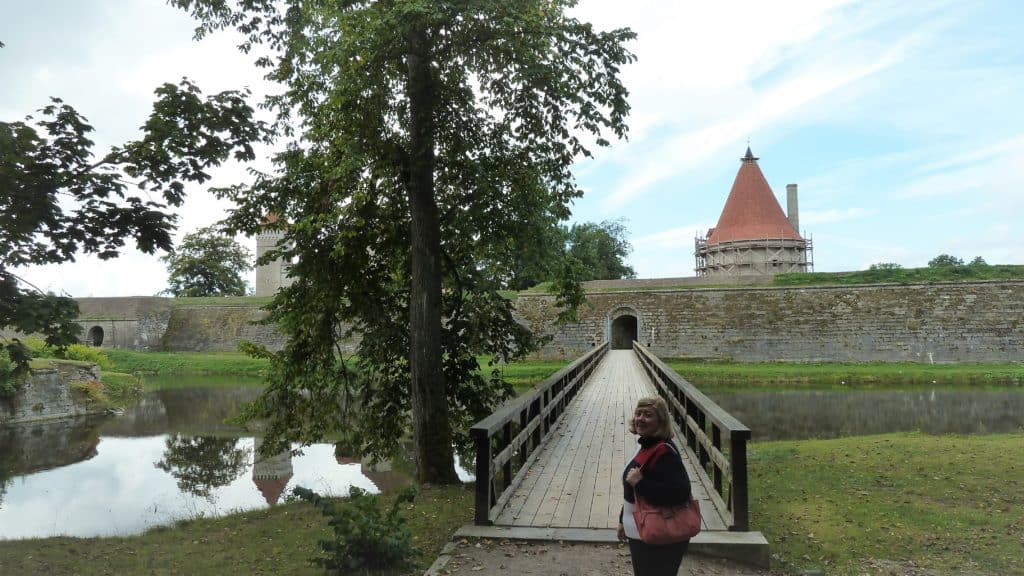
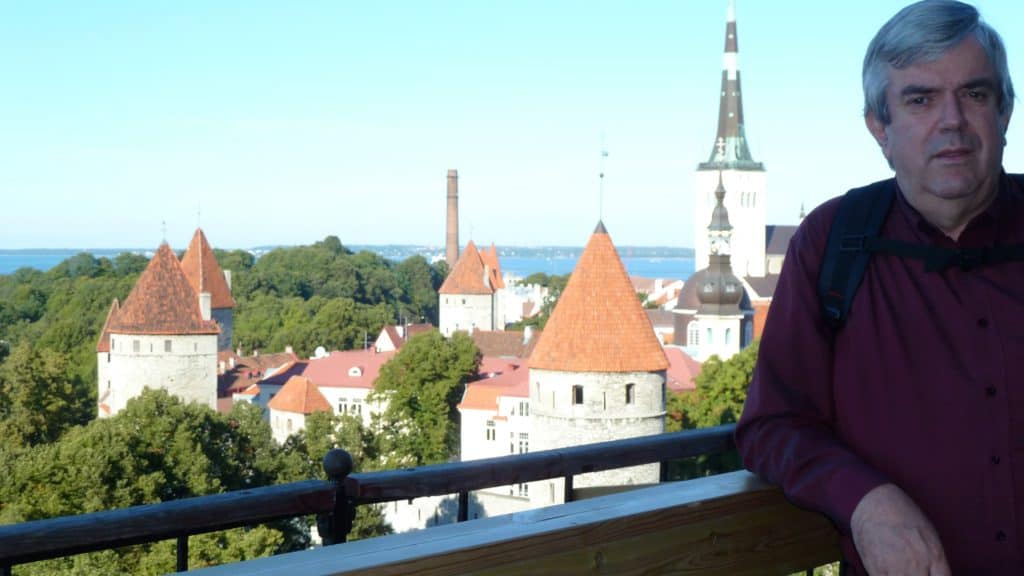
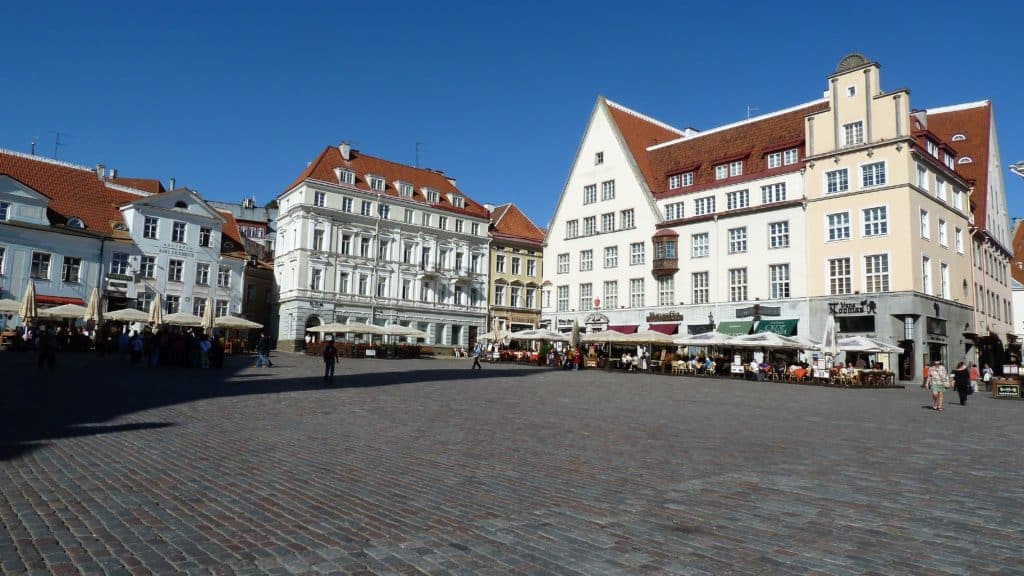
Leave a Reply